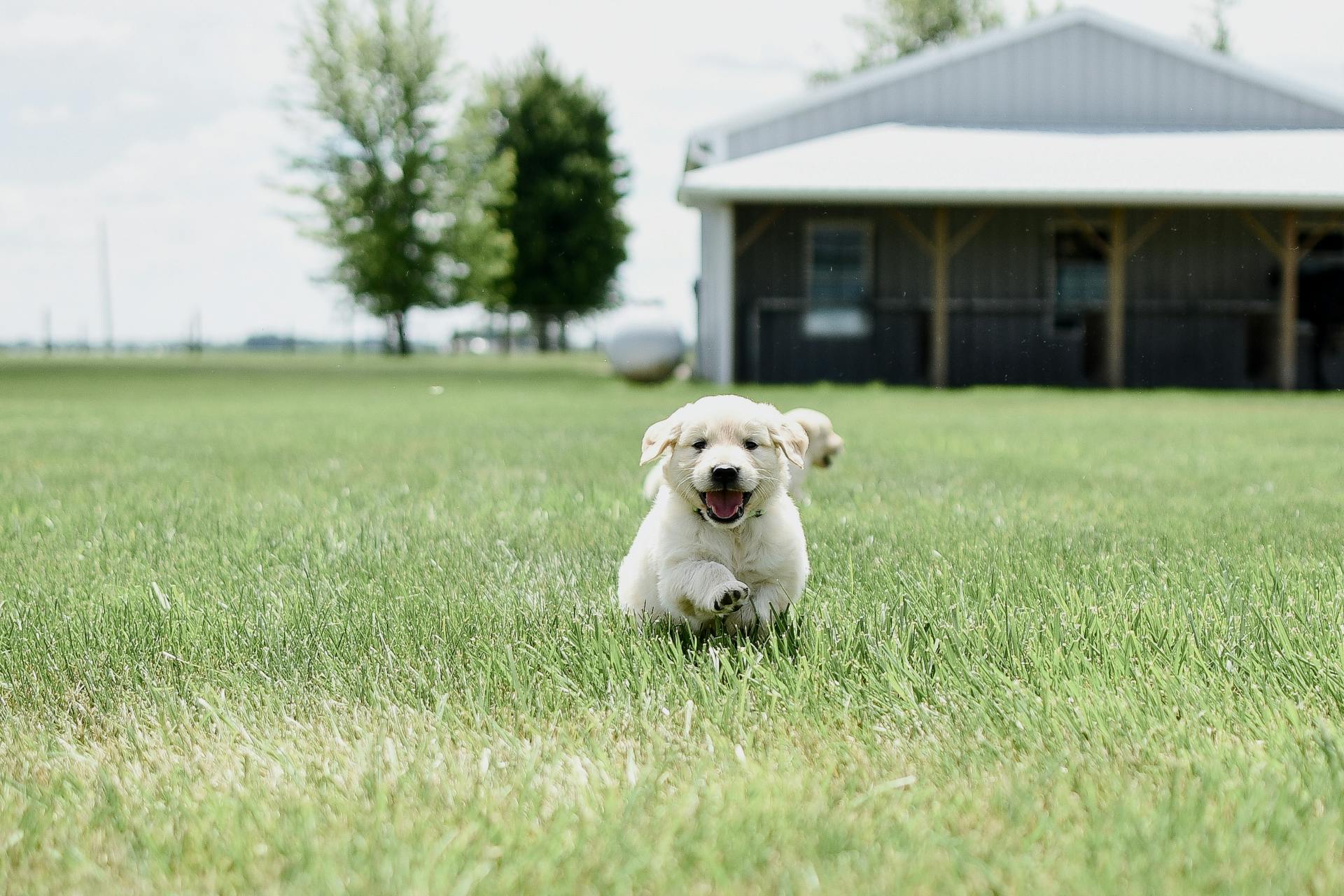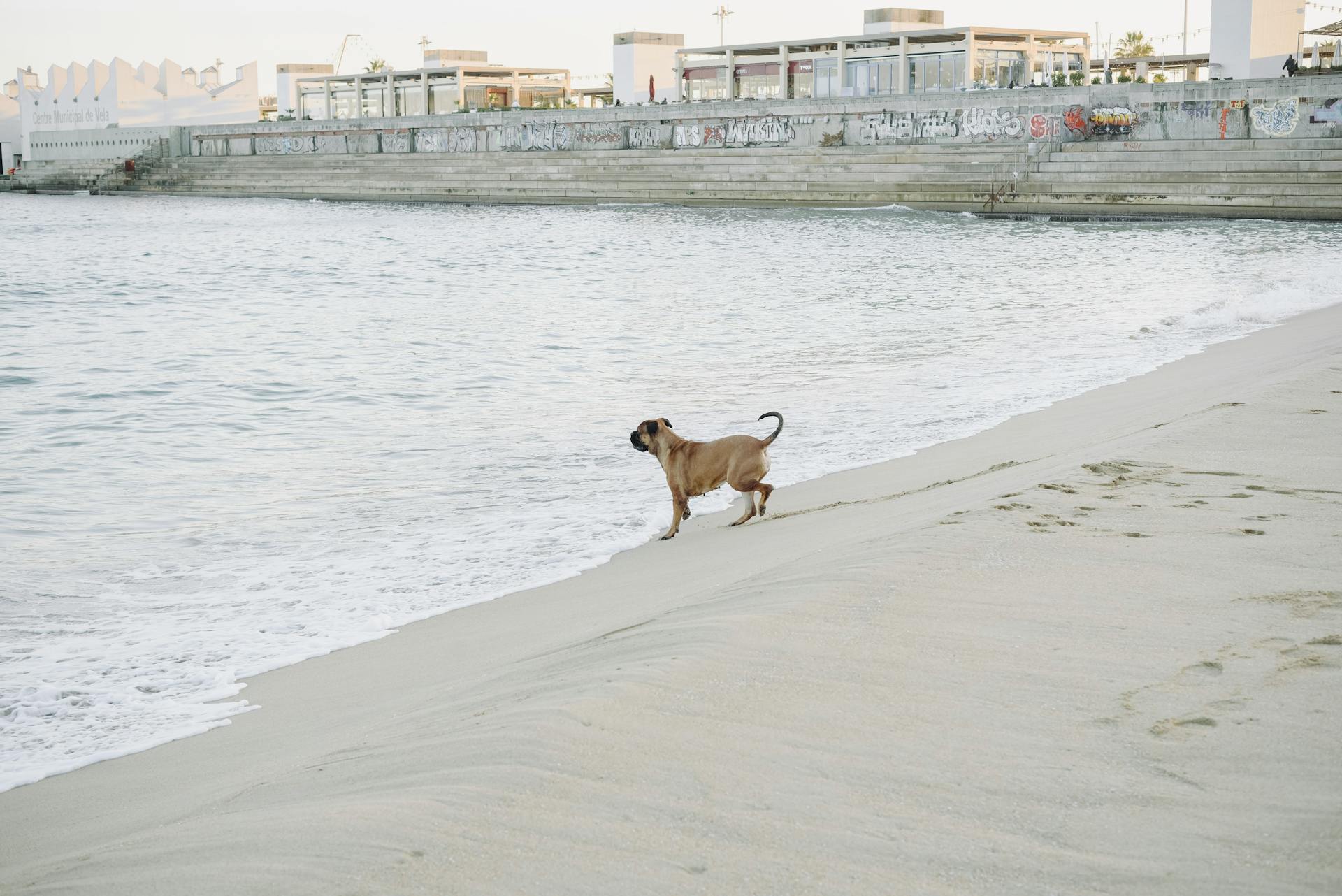
Bullmastiffs can weigh between 110 and 130 pounds on average.
Their large size can lead to joint issues, such as hip dysplasia, which can cause arthritis and mobility problems.
Bullmastiffs are prone to obesity, which can exacerbate joint issues and lead to other health problems.
Regular exercise and a balanced diet are crucial in maintaining a healthy weight for bullmastiffs.
See what others are reading: Bullmastiff Health Problems
Diet
Your Bullmastiff's diet is crucial for maintaining a healthy weight. A high-quality and well-balanced diet that meets AAFCO standards is essential.
You should look for a statement on the label that says the food meets AAFCO standards. This ensures your Bullmastiff gets the necessary nutrients.
Follow the recommended feeding chart on commercial dog food to avoid overfeeding. Your veterinarian can help guide you on how much and how often to feed your Bullmastiff based on their age, health, and lifestyle.
Puppy food specifically formulated for large dog breeds can be beneficial for Bullmastiff puppies. Brands like Hill's, Purina, and Royal Canin offer such formulas.
Dog treats count as calories, so be mindful of the balance between meals and treats.
A unique perspective: Weight Gain Dog Treats
Physical Health

Bullmastiffs are prone to a number of health issues, but with the right care and attention, they can live happy, long lives.
Hip and Elbow Dysplasia is a common issue in large-breed dogs like the Bullmastiff, where the joint doesn't fit properly. This can often be managed by maintaining a healthy weight and providing regular exercise.
If you're purchasing a puppy from a breeder, be sure to ask if the parents have been health screened and had their hips and elbows certified by OFA.
Gastric Dilatation-Volvulus (GDV), also known as bloat, is a life-threatening condition where the stomach rotates and twists on itself. To help prevent GDV, feed your pup two or three smaller meals throughout the day instead of a large meal.
Mast cell tumors (MCTs) are a type of skin cancer that often looks like more benign lumps. If you notice any new lumps, contact your vet to get them checked out.
Here are some common health issues that can affect Bullmastiffs:
- Hip and Elbow Dysplasia
- Gastric Dilatation-Volvulus (GDV)
- Cancer (Lymphoma and Mast Cell Tumors)
- Dilated Cardiomyopathy (DCM)
- Entropion
Exercise and Size
Bullmastiffs don't need hours of daily exercise, about 30 to 45 minutes is plenty.
They're happy to go on a walk or spend time in a fenced-in yard, which helps prevent obesity and boredom.
A daily walk and playtime are great ways to strengthen your bond with your Bullmastiff.
The breed is moderately sensitive to hot weather, so plan outdoor activities around the cooler parts of the day.
Bullmastiffs are generally smaller than Mastiffs, but both breeds share a similar structure and outline.
The Mastiff is the heaviest breed in the AKC, with males weighing up to 240 pounds and females up to 210 pounds.
In contrast, Bullmastiffs weigh between 110 to 130 pounds for males and 100 to 120 pounds for females.
Exercise
Bullmastiffs have moderate energy levels, so they don’t need hours of daily exercise (about 30 to 45 minutes is plenty). A daily walk and playtime spent in a fenced-in yard are great ways to prevent obesity and boredom.

They're not high-energy dogs, so you don't need to worry about exhausting them with long runs. Bullmastiffs are just as happy to go on a walk as they are cozying up on the couch to watch TV.
If you live in a hot climate, plan your outdoor activities around the cooler parts of the day, as these dogs are moderately sensitive to hot weather.
Discover more: How Much Do Maltese Dogs Weigh
Size Matters
The size difference between breeds can be quite striking, and it's no exception with the Mastiff and Bullmastiff. The Mastiff is the heaviest breed in the AKC, with males weighing as much as 240 pounds and females 210 pounds.
The weight of the Bullmastiff is significantly lower, with males weighing between 110 to 130 pounds and females 100 to 120 pounds. This is a notable contrast to the Mastiff's massive size.
The rectangular profile of the Mastiff gives it a massive, imposing appearance, with heavy bone, a prominent breastbone, and great depth of body. This unique combination of characteristics sets the Mastiff apart from other breeds.
The Bullmastiff, on the other hand, is nearly square in body appearance, showing great strength, endurance, and alertness, as well as powerfully built but active.
For another approach, see: Great Dane Bullmastiff Irish Wolfhound
Frequently Asked Questions
Which is bigger, Bullmastiff or English Mastiff?
English Mastiffs generally weigh more than Bullmastiffs, with males reaching up to 240 pounds compared to the Bullmastiff's 130 pounds. This significant size difference makes English Mastiffs the larger breed.
Sources
Featured Images: pexels.com
